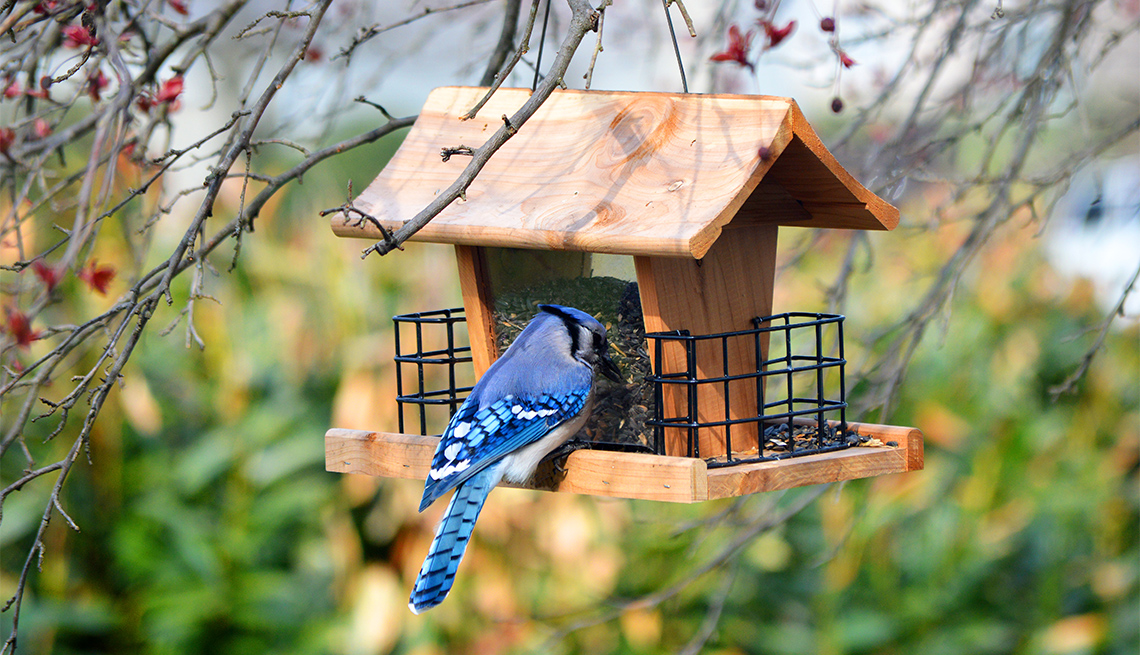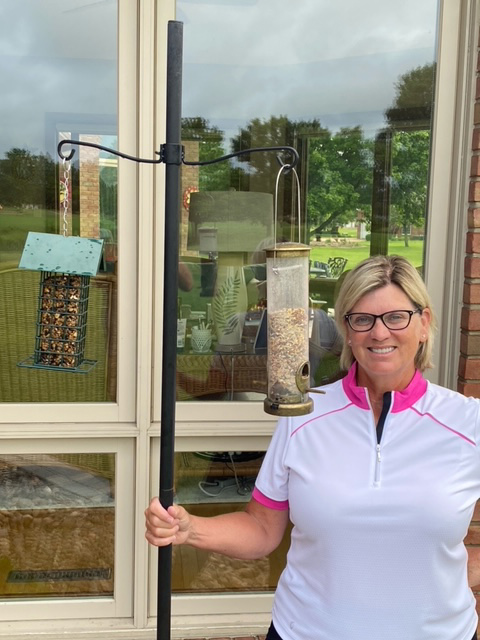Lenore Foster, 74, used to have bird feeders in the front yard of her home in Kerhonkson, New York.
Although Foster loved watching the birds, she also recalls the hassle of having to find metal storage containers to keep her birdseed safe from rodents. Then there were the squirrels that invaded her feeder, knocking seeds onto the ground and making a mess. A rabid raccoon once took over the feeder, and the birdseed eventually attracted a hungry bear.
"We watched as a black bear pulled the pole right out of the ground and carried it, along with the feeder, into the woods, never to be seen again,” says Foster. “And that was the end of my bird feeders in the mountains.”
Foster is not alone. Many people with bird feeders have had unexpected adventures. “Bird feeders are definitely a responsibility,” says Jordan Rutter, director of public relations for the American Bird Conservancy. “They have a lot of great things that come with them, like being able to have birds closer to you. But they also require regular upkeep, both for your own health and the birds.”
Bird feeders can be messy and unhygienic, and they may even put local birds in harm's way.
Here are six reasons you may not want a bird feeder.
1. They are messy
Birds are not the cleanest of eaters. They flick seeds and shells all over the ground — “especially with sunflower seeds or peanuts that come in shells,” says Rutter. “Birds don't have teeth, so they're not chewing. But as they are getting to the actual feed they want to eat, they can leave behind remnants of those seeds.”
Those leftover seeds can cause unwanted flowers and plants to sprout beneath your feeder. And birds poop frequently, which means droppings all over your bird feeders and the need for frequent cleaning.
2. They can involve lot of upkeep
Better Ways to Bird-watch
If you're willing to put in the work, bird feeders can offer a fun way to watch native birds in your own backyard. But Adam Brewerton with the Utah Department of Wildlife Resources says there is a far easier way to enjoy them, without the costs or maintenance involved in keeping a bird feeder.
He suggests attracting local birds to your yard by planting natives — “plants that will provide some type of habitat or food source or cover.”
Attracting birds in this more natural way allows people to “see and enjoy them, but it won't necessarily pull them in high concentrations like a feeder,” he says. Plus, he says, “a lot of the concerns about disease, upkeep and maintenance go away.”
Opt for plants with funnel flowers, like penstemon, which hummingbirds enjoy, or ask your local garden shop for recommendations about plants that attract insects and other local pollinators. Brewerton also recommends berry-producing plants, like snowberry shrubs, that birds like to feed on.
"Bird feeders are basically the kitchens and dining rooms of our backyards,” says Rutter. “So bird feeders are similar to plates and glasses and silverware that people would eat from.”
We wash our dishes and utensils after each use; Rutter says we should think of bird feeders in a similar way — with the need for regular cleaning and fresh birdseed. This helps to keep a feeder hygienic and prevents old or moist seed from causing mold to grow.
Rita McMahon, director of the Wild Bird Fund, says you should ideally clean a bird feeder at least once a week, using a 10 percent bleach and 90 percent water solution. And anytime seed gets wet, you'll want to replace it.
3. They can be pricey
The costs of maintaining a feeder can add up. “I have a suet feeder and buy cakes for those,” says Rutter. “There have been times when the birds have eaten one in an entire day. And then there have been times where it's taken a whole week.”
Rebecca Delahaye-Beekman, 59, from Dyer, Indiana, feeds between 30 and 50 birds daily at five feeders and spends $45 a month on birdseed. “I have to fill them every three to four days in the spring, summer and early fall, then about once a week in the winter,” she says.
If you want seeds that won't sprout plants under your feeders, you'll need to buy ungerminated seed, which Adam Brewerton, a wildlife conservation biologist with the Utah Department of Wildlife Resources, says can be more expensive. There's also the cost of specialty items, like squirrel guards and even, in a situation like Foster's, a whole new bird feeder when a bear makes off with it.
4. They attract unwanted critters
Birdseed can attract creatures not of the avian variety. Squirrels, chipmunks and raccoons love the seed, and they can become destructive and knock down feeders or gnaw through plastic to get to what they're after. You'll also need to come up with a system for storing your birdseed, as critters like rats and mice can chew through plastic bags of seed stored in places like your garage.
"You always want to make sure that you put any birdseed in an airtight sealed container,” ideally metal, Rutter says.
5. They bring health concerns
"Whenever you feed wildlife, and it brings multiple animals together and concentrates them, it always increases the chance for disease transmission,” says Brewerton. “And backyard bird feeding has always been the most common and widespread practice of feeding wildlife.”
In situations where birdseed is spread out with easy access, like on a platform feeder, birds may poop right into the feed. If another bird eats these contaminated seeds, it can spread salmonella. “It's not necessarily a direct risk to humans, as you're probably not going to be eating contaminated birdseed yourself. But you might touch it, it might get on your hands, and then you might go eat a snack or something,” he explains.
Birds can also carry mites and insects. When Brittany Hodak, 37, and her family put up a bird feeder, they noticed an increase in ticks near their home in Franklin, Tennessee. “Our exterminator told us bird feeders were the number one contributing factor to ticks in our backyard and therefore on our dogs,” she says. “We got rid of the bird feeders and the ticks were gone immediately.” Rodents coming into your yard to eat birdseed may also carry diseases.
6. They can do more harm than good to local wildlife
Many people place bird feeders near windows, but Rutter warns that this can cause birds to fly into glass and become injured or die. To help avoid this, outfit your windows with decals, UV stickers, bird tape, netting or screens to help feathered visitors see the glass.
Having a bird feeder can bring lots of kinds of birds into your yard, including invasive nonnative species. “Starlings, for example, will often take over a bird feeder,” Brewerton explains. “They'll actually pretty aggressively chase other birds away from it.” Also, when birds congregate, neighborhood cats can gather to more easily pick them off.
Save 25% when you join AARP and enroll in Automatic Renewal for the first year. Get instant access to discounts, programs, services, and the information you need to benefit every area of your life.
"bird" - Google News
July 06, 2021 at 11:40PM
https://ift.tt/3dQuaCx
6 Reasons You Might Not Want a Bird Feeder - AARP
"bird" - Google News
https://ift.tt/2s1zYEq
https://ift.tt/3dbExxU
Bagikan Berita Ini


















0 Response to "6 Reasons You Might Not Want a Bird Feeder - AARP"
Post a Comment